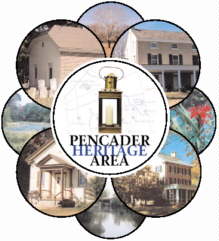 The little railroad George Alfred Townsend refers to is the Frenchtown Railroad, the first railroad in Delaware. Travelers from
Philadelphia on their way to Baltimore took a steamboat to New Castle, where they boarded the train to Frenchtown. (Never more
than a small cluster of houses on the Elk River in Maryland, the town was burned by the British in 1813.) At Frenchtown they would
again board a steamboat headed down the Chesapeake to Baltimore.
The little railroad George Alfred Townsend refers to is the Frenchtown Railroad, the first railroad in Delaware. Travelers from
Philadelphia on their way to Baltimore took a steamboat to New Castle, where they boarded the train to Frenchtown. (Never more
than a small cluster of houses on the Elk River in Maryland, the town was burned by the British in 1813.) At Frenchtown they would
again board a steamboat headed down the Chesapeake to Baltimore.
The sixteen miles of wooden tracks, held onto eighteen-inch square stone blocks by L-shaped pieces of iron were capped by a
metal top rail. These stones can still be found along the old roadway, easily identified by the two holes drilled in each one, eight
inches apart into which were inserted wooden plugs. The iron fasteners were spiked into these plugs in order to hold the rails, about six inches square, in place. The cars, which were little more than glorified stagecoaches, were pulled along the rails by horses until they were later replaced by a steam engine.
The history of the railroad is one of the best-kept secrets in Delaware. The residents of New Castle are among the few Delawareans aware of its significance as possibly the third railroad in the United States to carry passengers. A pyramid-shaped monument composed of the sleeper stones and a section of the town park displaying the old ticket booth with a reconstruction of the rail system, are tributes to the brave experiment in travel. A historical marker in nearby Packet Alley lists some of the more notable
passengers willing to speed down the tracks at fifteen miles an hour surrounded by flying sparks. One of them was Daniel Boone who wrote of the experience in his diary. In existence from 1832 to 1853 it also has the singular distinction of being the first railroad abandoned in the United States.
|
